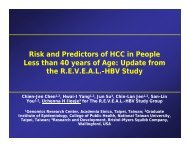Impact of the Drug Use and Substitution Treatments
Impact of the Drug Use and Substitution Treatments
Impact of the Drug Use and Substitution Treatments
Create successful ePaper yourself
Turn your PDF publications into a flip-book with our unique Google optimized e-Paper software.
<strong>Impact</strong> <strong>of</strong> <strong>the</strong>PresentedChronic Hepatitis1Hôpital Général, SaAbstractBackground <strong>and</strong> aims: CHEOBS is a French multicenter, prospective, observational study that aimed to analyse<strong>the</strong> factors associated with adherence to treatment with peginterferon alfa-2b <strong>and</strong> ribavirin in chronic hepatitisC patients. The present analysis focuses on adherence to antiviral dual <strong>the</strong>rapy, virological response, <strong>and</strong> quality <strong>of</strong>life (QoL) according to whe<strong>the</strong>r <strong>the</strong> patients were active drug users or under substitution treatment (ADU), ex-drugusers (EDU), or non-drug users (NDU).Patients <strong>and</strong> methods: Between 2003 <strong>and</strong> 2006, 184 clinicians evaluated 2001 hepatitis C patients every 3 monthsduring treatment <strong>and</strong> 6 months after <strong>the</strong> end <strong>of</strong> treatment. Among <strong>the</strong>se patients, 141 were excluded from <strong>the</strong> analysis.The studied population included 244 ADU, 578 EDU <strong>and</strong> 1038 NDU. Good adherence was defined by >80% <strong>of</strong> <strong>the</strong>dose <strong>and</strong> duration <strong>of</strong> <strong>the</strong> antiviral dual <strong>the</strong>rapy prescribed. Sustained virological response (SVR) was defined by anegative PCR ≥12 weeks after <strong>the</strong> end <strong>of</strong> treatment. QoL was assessed using <strong>the</strong> SF-36 questionnaire.Results: The patient pr<strong>of</strong>ile in <strong>the</strong> EDU group was between that in <strong>the</strong> ADU <strong>and</strong> NDU groups for mean age, body massindex (BMI), liver fibrosis, level <strong>of</strong> education or debt difficult to manage, high consumption <strong>of</strong> alcohol, psychiatricdisorders, or chronic diseases. The proportion <strong>of</strong> good adherents to dual <strong>the</strong>rapy was similar in all three groups:NDU, 49.4%; EDU, 48.6%; ADU, 52.2% (p=0.7). The SVR rate was also similar: 49.3%, 50.9%, <strong>and</strong> 57.8%, respectively(p=0.1). The QoL in <strong>the</strong> ADU group was less altered on <strong>the</strong> physical <strong>and</strong> mental levels than in <strong>the</strong> o<strong>the</strong>r groups.Conclusions: The rate <strong>of</strong> SVR was similar in <strong>the</strong> three groups. Excess consumption <strong>of</strong> alcohol, a precarious socioeconomicsituation, <strong>and</strong> <strong>the</strong> psychiatric disorders observed in drug users in this study had no negative impact on<strong>the</strong> treatment outcomes. On <strong>the</strong> contrary, young age, recent contamination, high prevalence <strong>of</strong> genotype 3 infection,lower BMI, less severe liver fibrosis, <strong>and</strong> good adherence to treatment seem to have balanced <strong>the</strong> negative parameters.Background• The French Consensus Conference <strong>of</strong> February 2002 recommended treating patients infected with hepatitis C virus(HCV) with stable drug use 1• Key findings from <strong>the</strong> Hepacom Study, a 12-month, multicenter, observational prospective study <strong>of</strong> treatment-naivechronic hepatitis C patients treated in <strong>the</strong> French health care system, were 2 :— Only one-third <strong>of</strong> patients with access to health care initiated antiviral treatment— Access to treatment was more difficult among <strong>the</strong>se patient populations:WomenHIV-coinfected patients<strong>Drug</strong> users receiving substitution <strong>the</strong>rapy• Data from Hepacom revealed that health care access was still limited for drug users, suggesting that fur<strong>the</strong>r study<strong>of</strong> this patient population was neededAim• This analysis from <strong>the</strong> CHEOBS study compared <strong>the</strong> efficacy, tolerability, compliance, <strong>and</strong> effect on quality <strong>of</strong> life<strong>of</strong> pegylated interferon (PEG-IFN) alfa-2b (PegIntron ® ; Schering-Plough) + ribavirin (RBV) in 3 groups <strong>of</strong> patientswith chronic hepatitis C— Non-drug users (NDU)— Ex-drug users (EDU)— Active drug users or users undergoing substitution treatment (ADU)Patients <strong>and</strong> MethodsPatients• Patients aged 18 <strong>and</strong> older who had chronic hepatitis C <strong>and</strong> initiated treatment with PEG-IFN alfa-2b (1.5 µg/kg/wk)alone or in combination with RBV (800-1200 mg/d, depending on body weight) were eligible for enrollment• Patients were treatment naive or were nonresponders or relapsers to previous anti-HCV <strong>the</strong>rapyStudy Design• The CHEOBS study was a prospective, multicenter, observational study conducted between 2003 <strong>and</strong> 2006• Patients were enrolled from 184 centers in France that specialize in <strong>the</strong> management <strong>of</strong> hepatitis C





